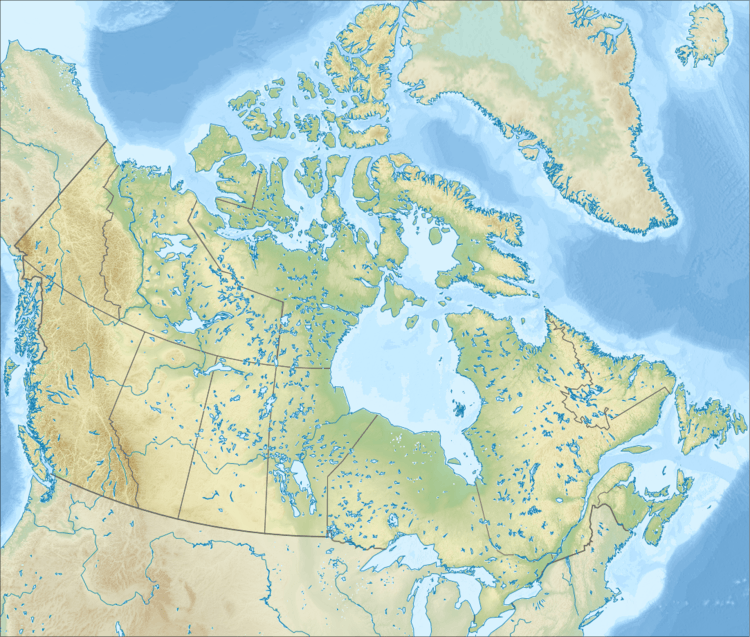Odaray Mountain
Odaray Mountain is a 3,137-metre (10,292-foot) summit located west of Lake O'Hara in the Bow Range of Yoho National Park, in the Canadian Rockies of British Columbia, Canada. Its nearest higher peak is Mount Huber, 3.86 km (2.40 mi) to the east.[2] The standard climbing route follows the southeast glacier and ridge starting from Elizabeth Parker hut. Pronunciation sounds like the two words "ode array" (/ōd/ /əˈrā/).
| Odaray Mountain | |
|---|---|
.jpeg) Odaray Mountain reflected in Lake O'Hara | |
| Highest point | |
| Elevation | 3,137 m (10,292 ft) [1] |
| Prominence | 627 m (2,057 ft) [2] |
| Parent peak | Mount Stephen (3200 m)[2] |
| Listing | Mountains of British Columbia |
| Coordinates | 51°21′37″N 116°23′03″W [3] |
| Geography | |
 Odaray Mountain Location of Odaray Mountain in British Columbia  Odaray Mountain Odaray Mountain (Canada) | |
| Location | British Columbia, Canada |
| Parent range | Canadian Rockies |
| Topo map | NTS 82N08[3] |
| Geology | |
| Age of rock | Cambrian |
| Type of rock | shale, limestone |
| Climbing | |
| First ascent | 1887 by James J. McArthur (solo) |
| Easiest route | Scrambling |
History
The first ascent of the mountain was made in 1887 by James J. McArthur, and he named it Odaray which is the expression for "many waterfalls" in the Stoney language.[4] Other reports have it being named in 1894 by Samuel Evans Stokes Allen for the Stoney Indian word for "cone".[5] However, it is possible that McArthur only ascended the lesser secondary summit cone (2965 m) now known as Little Odaray which is southeast of the true summit.[6][7] The mountain's current name became official in 1952 when the Geographical Names Board of Canada rescinded the name Mount Odaray.[3]
Geology
Odaray Mountain is composed of sedimentary rock laid down during the Precambrian to Jurassic periods.[8] Formed in shallow seas, this sedimentary rock was pushed east and over the top of younger rock during the Laramide orogeny.[9]
Climate
Based on the Köppen climate classification, Odaray Mountain is located in a subarctic climate with cold, snowy winters, and mild summers.[10] Temperatures can drop below −20 °C with wind chill factors below −30 °C. Precipitation runoff from Odaray Mountain drains into tributaries of the Kicking Horse River which is a tributary of the Columbia River.

References
- "Odaray Mountain, British Columbia". Peakbagger.com. Retrieved 2019-09-08.
- "Odaray Mountain". Bivouac.com. Retrieved 2018-11-13.
- "Odaray Mountain". Geographical Names Data Base. Natural Resources Canada. Retrieved 2018-11-13.
- "Odaray Mountain". PeakFinder.com. Retrieved 2019-09-08.
- "Odaray Mountain". BC Geographical Names. Retrieved 2019-09-08.
- "Little Odaray, Canada". Peakbagger.com. Retrieved 2019-08-08.
- Sokoloff, Carol Ann (2002). Eternal Lake O'Hara. Victoria, BC: Ekstasis Editions. p. 19. ISBN 9780921215714. Retrieved 2019-09-08.
- Belyea, Helen R. (1960). The Story of the Mountains in Banff National Park (PDF). parkscanadahistory.com (Report). Ottawa: Geological Survey of Canada. Archived (PDF) from the original on 2015-10-02. Retrieved 2019-09-13.
- Gadd, Ben (2008). Geology of the Rocky Mountains and Columbias.
- Peel, M. C.; Finlayson, B. L. & McMahon, T. A. (2007). "Updated world map of the Köppen−Geiger climate classification". Hydrol. Earth Syst. Sci. 11: 1633–1644. ISSN 1027-5606.
External links
| Wikimedia Commons has media related to Odaray Mountain. |
- Odaray Mountain Weather forecast
- Parks Canada web site: Yoho National Park
- Climbing Little Odaray: explor8ion.com